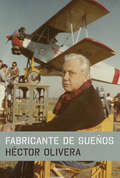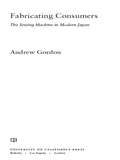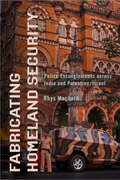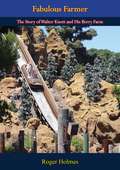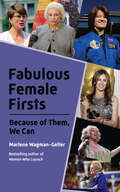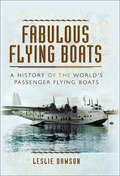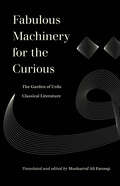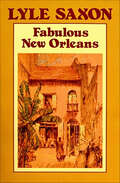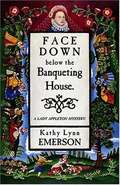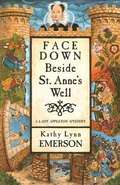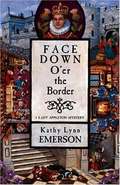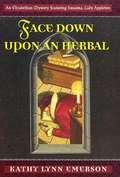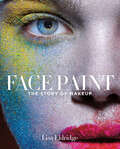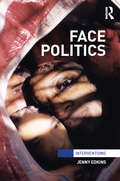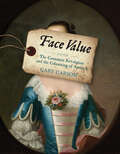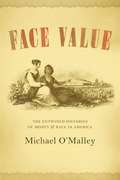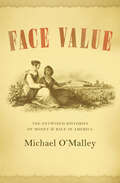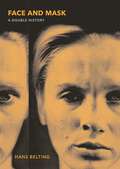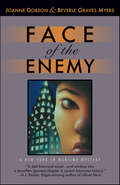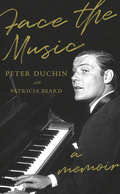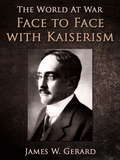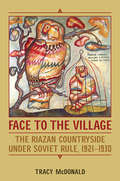- Table View
- List View
Fabricante de sueños
by Héctor OliveraVida y obra de uno de los productores y directores más importantes y prolíficos del cine argentino, contada por él mismo con lucidez, gracia, convicción y sensibilidad en un relato que entrevera su pasión por el cine, el devenir político de la Argentina a lo largo de casi noventa años y un irresistible conjunto de anécdotas personales que incluyen grandes revelaciones sobre su vida íntima y amorosa. Es imposible pensar el cine argentino sin Héctor Olivera. Protagonista de una vida que vale por varias, a sus casi noventa años se detiene un momento para recordar el largo camino transitado. Pródigo en anécdotas su relato comprende, entre otras historias, la de las más de cien películas que hizo como director o como productor bajo el sello Aries, empresa fundamental del cine argentino, que creó con su socio y amigo Fernando Ayala. En sus films -que capturaron el espíritu de su época, en ocasiones desafiando una violenta censura-, Olivera adaptó obras de Borges, Soriano, Bayer, Cossa y Viñas, entre otros; enriquecidas por actores como Federico Luppi, Pepe Soriano, Héctor Alterio, Luis Brandoni, Oscar Martínez, Norman Briski; actrices como Mirtha Legrand, Norma Aleandro, Thelma Biral, Cecilia Roth, Susana Giménez, y cómicos de la talla de Sandrini, Olmedo y Porcel. Al mismo tiempo, recorre el siglo XX argentino, haciendo eje en el peronismo con una honesta y personal combinación de rechazo y fascinación por la figura de su líder. En el encuentro de estos recorridos toma forma una biografía que Olivera despliega con gracia, sensibilidad y el espíritu vibrante que marcó cada uno de sus proyectos.
Fabricating Consumers
by Andrew GordonSince its early days of mass production in the 1850s, the sewing machine has been intricately connected with the global development of capitalism. Andrew Gordon traces the machine's remarkable journey into and throughout Japan, where it not only transformed manners of dress, but also helped change patterns of daily life, class structure, and the role of women. As he explores the selling, buying, and use of the sewing machine in the early to mid-twentieth century, Gordon finds that its history is a lens through which we can examine the modern transformation of daily life in Japan. Both as a tool of production and as an object of consumer desire, the sewing machine is entwined with the emergence and ascendance of the middle class, of the female consumer, and of the professional home manager as defining elements of Japanese modernity.
Fabricating Homeland Security: Police Entanglements across India and Palestine/Israel (South Asia in Motion)
by Rhys MacholdHomeland security is rarely just a matter of the homeland; it involves the circulation and multiplication of policing practices across borders. Though the term "homeland security" is closely associated with the United States, Israel is credited with first developing this all-encompassing approach to domestic surveillance and territorial control. Today, it is a central node in the sprawling global homeland security industry worth hundreds of billions of dollars. And in the wake of the 2008 Mumbai terrorist attacks, India emerged as a major growth market. Known as "India's 9/11" or simply "26/11," the attacks sparked significant public pressure to adopt "modern" homeland security approaches. Since 2008, India has become not only the single largest buyer of Israeli conventional weapons, but also a range of other surveillance technology, police training, and security expertise. Pairing insights from science and technology studies with those from decolonial and postcolonial theory, Fabricating Homeland Security traces 26/11's political and policy fallout, concentrating on the efforts of Israel's homeland security industry to advise and equip Indian city and state governments. Through a focus on the often unseen and overlooked political struggles at work in the making of homeland security, Rhys Machold details how homeland security is a universalizing project, which seeks to remake the world in its image, and tells the story of how claims to global authority are fabricated and put to work.
Fabulous Farmer: The Story of Walter Knott and His Berry Farm
by Paul Bailey Roger HolmesTWENTY MILLION people have walked the acres of Knott’s Berry Farm at Buena Park, California. Its chicken dinners, its wild west atmosphere, its “Ghost Town,” are familiarly known to travellers from every part of the world. Less known, perhaps, is the remarkable story of Walter Knott and his family, who have built their strange enterprise into one of the wonder of the west.Here is the story of how a once penniless sharecropper parlayed ten acres of berries into a farm of golden wonders. How a chicken dinner became a national institution, ad how boysenberries, both in an out of pies, became the means of assembling on hundred acres of historical marvels that have delighted and amused the Farm’s millions of visitors.FABULOUS FARMER is the tale of how one man turned poverty and adversity into dazzling success. It is a story of free American enterprise with odd and new twists. It is an inspiring, human recital of a family whose teamwork, thrift and industry fought through every hardship and crisis until success was theirs. Through its candid, exciting pages breathes the same warmth and friendliness that is so deeply senses by every visitor to the Farm.FABULOUS FARMER is as typically American as Mrs. Knott’s berry pies and fried chicken. It is a joyful, rewarding book that builds courage and faith in its readers, and a book every American will want to read as tonic for his own fears, and antidote for anything that might water down his faith in the future and his belief in himself.
Fabulous Female Firsts: Because of Them, We Can
by Marlene Wagman-GellerProfiles of pioneering women past and present who&’ve shattered glass ceilings from the author of Women of Means and Women Who Launch. Sexism has kept generations of women on the sidelines of history—but in every era, there are women who refuse to sit back in the shadows. Fabulous Female Firsts is a celebration of those women—the role models who proved that with enough daring and tenacity, the impossible can become possible.From the first woman to receive the Congressional Medal of Honor to the first female candidate for US President (it wasn&’t Hillary Clinton!) to the first woman to win an Academy Award for Best Director, this collection of biographical profiles celebrates the trailblazers who persisted—in spite of being labeled stubborn, improper, or worse. This book is written in praise of &“difficult women&” who made the world a better place, and offers the inspiring stories of: Aretha Franklin • Sandra Day O&’Connor • Lucy Walker • Sally Ride • Kathryn Bigelow • Misty Copeland • Viola Desmond • Pauli Murray • Emma Gatewood • Brig. Gen. Anna Hays • Junko Tabei • Gertrude Ederle and many more. &“Effervescent stories about diverse groups of female creators, entrepreneurs, and dynamos . . . every page gives the motivation to strive for greatness.&” —Becca Anderson, bestselling author of The Book of Awesome Women and Real Life Mindfulnes
Fabulous Flying Boats: A History of the World's Passenger Flying Boats
by Leslie DawsonThe history of the development and operations of flying boats in the early twentieth century is a vibrant one, full of colourful characters and experimentation. In 'Fabulous Flying Boats', Leslie Dawson captures this spirit of dynamism, reminding us of the most successful early pioneers of the seaplanes development, including a little known and oft-overlooked rival to the Wright Brothers, working to put their mutual successes in context. He goes on to describe, in clear and vivid detail, and using first hand-accounts, what it was like to be aboard one of the resulting huge passenger flying boats, as air crew and as a passenger. He also recounts the part played by the military boats inevitably seconded to such use. Incredibly well researched, the narrative embraces the globe-trotting air routes, from Europe to the Far East and to the Americas, and is well supported with evocative images from private and corporate collections, and the worlds aviation museums. The in-depth Appendix is virtually a book in itself. This book is sure to be a welcome addition to any Aviation enthusiasts library as it covers a particularly important period of Aviation development which formed a fertile environment for a host of young experimenters. The process of development continues to this day.
Fabulous Machinery for the Curious: The Garden of Urdu Classical Literature (World Literature In Translation Ser.)
by Musharraf Ali FarooqiAn absorbing, joyous, and colorful collection of stories from the qissa genre. Fabulous Machinery for the Curious presents the first English translation of some of the finest texts from the qissa genre. In this book, acclaimed translator Musharraf Ali Farooqi gathers the greatest of these tales, written or transcribed in the Urdu language by master storytellers in the eighteenth and nineteenth centuries. Spreading from Persia to Arabia to South Asia over 1,500 years, the qissa appropriated verse and prose narratives to become the preeminent storytelling genre. The combined traditions of the many cultures of Indo-Islamic civilization resulted in a flowering of qissas in Urdu. This collection distills a vast body of oral and written literature, from resplendent sagas of romantic love and thrilling adventures in fairyland to picaresque stories of deception and haunting tales of nobility and viciousness. Fabulous Machinery for the Curious brings these forgotten gems to a new generation of readers and reminds us of the abiding power that great stories and ancient genres have for engaging the contemporary world.
Fabulous New Orleans
by Lyle SaxonThis classic reprint evokes a city steeped in the traditions and idiosyncrasies of three cultures--French, Spanish, andAmerican. Known widely as one of Louisiana's great writers, Lyle Saxon documented many of the quirks and mysteries of New Orleans. His narratives include a vivid picture of Mardi Gras as seen through the eyes of a young boy, a brief history of the city, and accounts of strange and remarkable events, including the great Mississippi flood of 1927, the year of the great plague, and a voodoo cult ceremony.By any standards, New Orleans is a unique city, and Saxon depicts it unadorned, with all its flaws and glories.
Face Down Among the Winchester Geese (Lady Appleton Mystery #3)
by Kathy Lynn EmersonThird in Lady Susanna Appleton mystery series set in Elizabethan England.
Face Down Before Rebel Hooves (Lady Appleton Mystery #6)
by Kathy Lynn Emerson6th in mystery series featuring sleuth and herbalist Lady Susanna Appleton, set in Elizabethan England.
Face Down Below the Banqueting House (Lady Appleton Mystery #8)
by Kathy Lynn Emerson8th in Lady Susanna Appleton mystery series, set in Elizabethan England.
Face Down Beneath the Eleanor Cross (Lady Appleton Mystery #4)
by Kathy Lynn Emerson4th in mystery series featuring herbalist Lady Susanna Appleton. Set in Elizabethan England.
Face Down Beside St. Anne's Well (Lady Appleton Mystery #9)
by Kathy Lynn EmersonAre the nude spies lolling in the ancient Roman communal baths of Elizabethan England plotting the return of Mary Queen of Scots? She is said to be clamoring to return to these healing waters. Once again Susanna, Lady Appleton, encounters murder and treason, and only she can unravel the crimes in the intriguing year of 1575. Rosamund, Susanna's twelve-year-old foster daughter, is certain her French tutor has been murdered. Rosamund and her friends are quite modern: they cut school, rebel against authority, and giggle over secrets. But can teenage mischief be construed as spying and treason? These are most significant matters to the Elizabethans, as the wrong religion, the wrong marriage, the wrong friends...may all be seditious.
Face Down O'er the Border (Lady Appleton Mystery #10)
by Kathy Lynn EmersonThe year is 1557. Mary Queen of Scots is a prisoner in England, and Scotland is in upheaval. Does this political unrest tie in with a murder involving Susanna Appleton's friend Catherine, who has disappeared in the company of a notorious spy, and is now under suspicion of treason?
Face Down Upon an Herbal (Lady Appleton Mystery #2)
by Kathy Lynn EmersonSecond book in mystery series set in Elizabethan England, featuring sleuth and herbalist Lady Susanna Appleton.
Face Paint: The Story of Makeup
by Lisa EldridgeThe “exquisite and richly illustrated” New York Times bestseller from the renowned makeup artist, “a retrospective written for all women, everywhere” (Vogue France).Makeup, as we know it, has only been commercially available in the last 100 years, but applying decoration to the face and body may be one of the oldest global social practices. In Face Paint, Lisa Eldridge reveals the entire history of the art form, from Egyptian and Classical times up through the Victorian age and golden era of Hollywood, and also surveys the cutting-edge makeup science of today and tomorrow. Face Paint explores the practical and idiosyncratic reasons behind makeup’s use, the actual materials employed over generations, and the glamorous icons that people emulate, it is also a social history of women and the ways in which we can understand their lives through the prism and impact of makeup.“Makeup artist and Lancome global creative director Lisa Eldridge drops serious knowledge in Face Paint, her book on the history of beautifying.” —Marie Claire“Clear your coffee table and turn off YouTube—Lisa Eldridge’s book is a must read.” —Teen Vogue “The book is not only rich with history but also with a series of paintings, sketches and photographs in an intense array of colors, selected by the make-up artist herself in the most aesthetically pleasing universal statement to women you’ll ever see.” —Vogue France“Face Paint delves into the history of makeup, with glossy pictures to match . . . the book’s cover is striking.” —New York Post
Face Politics (Interventions)
by Jenny EdkinsThe face is central to contemporary politics. In Deleuze and Guattari’s work on faciality we find an assertion that the face is a particular politics, and dismantling the face is also a politics. This book explores the politics of such diverse issues as images and faces in photographs and portraits; expressive faces; psychology and neuroscience; face recognition; face blindness; facial injury, disfigurement and face transplants through questions such as: What it might mean to dismantle the face, and what politics this might entail, in practical terms? What sort of a politics is it? Is it already taking place? Is it a politics that is to be desired, a better politics, a progressive politics? The book opens up a vast field of further research that needs to be taken forward to begin to address the politics of the face more fully, and to elaborate the alternative forms of personhood and politics that dismantling the face opens to view. The book will be agenda-setting for scholars located in the field of international politics in particular but cognate areas as well who want to pursue the implications of face politics for the crucial questions of subjectivity, sovereignty and personhood.
Face Value: The Consumer Revolution and the Colonizing of America
by Cary CarsonThe Industrial Revolution was previously understood as having awakened an enormous, unquenchable thirst for material consumption. People up and down the social order had discovered and were indulging in the most extraordinary passion for consumer merchandise in quantities and varieties that had been unimaginable to their parents and grandparents. It was indeed a revolution, but a consumer revolution at the start.In Face Value, Cary Carson expands and updates his groundbreaking earlier work to address the intriguing question of how Americans became the world’s consummate consumers. Prior to the rise of gentry culture in eighteenth-century North America, there was still a decided sameness to people’s material lives. About mid-century, though, a lust for fancy goods, coupled with social aspiration, began to transform American society.Carson here addresses the intriguing question of how Americans developed the reputation for avid consumption. Both elegantly written and engagingly argued, the book reveals how the rise of the gentry culture in eighteenth-century North America gave rise to a consumer economy.
Face Value: The Entwined Histories of Money and Race in America
by Michael O'MalleyFrom colonial history to the present, Americans have passionately, even violently, debated the nature and the character of money. They have painted it and sung songs about it, organized political parties around it, and imprinted it with the name of God--all the while wondering: is money a symbol of the value of human work and creativity, or a symbol of some natural, intrinsic value? In Face Value, Michael O'Malley provides a deep history and a penetrating analysis of American thinking about money and the ways that this ambivalence unexpectedly intertwines with race. Like race, money is bound up in questions of identity and worth, each a kind of shorthand for the different values of two similar things. O'Malley illuminates how these two socially constructed hierarchies are deeply rooted in American anxieties about authenticity and difference. In this compelling work of cultural history, O'Malley interprets a stunning array of historical sources to evaluate the comingling of ideas about monetary value and social distinctions. More than just a history, Face Value offers us a new way of thinking about the present culture of coded racism, gold fetishism, and economic uncertainty.
Face Value: The Entwined Histories of Money and Race in America
by Michael O'MalleyThe cultural historian and author of Keep Watching analyses American ideas about race, money, identity, and their surprising connections through history. From colonial history to the present, Americans have passionately, even violently, debated the nature and of money. Is it a symbol of the value of human work and creativity, or a symbol of some natural, intrinsic value? In Face Value, Michael O&’Malley provides a penetrating historical analysis of American thinking about money and the ways that this ambivalence intertwines with race. Like race, money is bound up in questions of identity and worth, each a kind of shorthand for the different values of two similar things. O&’Malley illuminates how these two socially constructed hierarchies are deeply rooted in American anxieties about authenticity and difference. In this compelling work of cultural history, O&’Malley interprets a wide array of historical sources to evaluate competing ideas about monetary value and social distinctions. More than just a history, Face Value offers a new way of thinking about the present culture of coded racism, gold fetishism, and economic uncertainty. &“This is a &‘big idea&’ book that no one but Michael O&’Malley could even have thought of—much less pulled off with such nuance and clarity.&”—Scott A. Sandage, author of Born Losers
Face and Mask: A Double History
by Hans BeltingA cultural history of the face in Western art, ranging from portraiture in painting and photography to film, theater, and mass mediaThis fascinating book presents the first cultural history and anthropology of the face across centuries, continents, and media. Ranging from funerary masks and masks in drama to the figural work of contemporary artists including Cindy Sherman and Nam June Paik, renowned art historian Hans Belting emphasizes that while the face plays a critical role in human communication, it defies attempts at visual representation.Belting divides his book into three parts: faces as masks of the self, portraiture as a constantly evolving mask in Western culture, and the fate of the face in the age of mass media. Referencing a vast array of sources, Belting's insights draw on art history, philosophy, theories of visual culture, and cognitive science. He demonstrates that Western efforts to portray the face have repeatedly failed, even with the developments of new media such as photography and film, which promise ever-greater degrees of verisimilitude. In spite of sitting at the heart of human expression, the face resists possession, and creative endeavors to capture it inevitably result in masks—hollow signifiers of the humanity they're meant to embody.From creations by Van Eyck and August Sander to works by Francis Bacon, Ingmar Bergman, and Chuck Close, Face and Mask takes a remarkable look at how, through the centuries, the physical visage has inspired and evaded artistic interpretation.
Face of the Enemy (New York in Wartime Mysteries)
by Joanne Dobson Beverle Graves MyersIn this historical mystery series debut, when murder almost occurs at her doorstep, a young innkeeper in ancient Roman Britain must find who&’s responsible. Roman Britain in 91 AD is a raw frontier province, part of the mighty Empire ruled by Domitian Caesar. Though it is almost fifty years since the legions invaded, many native tribes still hate their conquerors and seize any chance to harass the Roman settlers who are flocking in to colonize the new province. Tension is especially high in the north, where Aurelia Marcella, a young innkeeper from Italy, runs the Oak Tree Inn on the road to York. A string of savage murders disrupts her peaceful life, and she and her Roman friends find themselves under attack from a secret native war-band whose aim is to drive all Romans out. When a traveler, Quintus, is nearly killed close to the inn, he and Aurelia must track down the rebel warriors and identify their mysterious masked leader, the Shadow of Death. Can they find and destroy him before his campaign of terror turns into open rebellion? Praise for Shadows in the Night&“Jane Finnis&’ gripping story of terrorism in Roman Britain is relevant and real for us today.&” —Rhys Bowen, New York Times–bestselling author &“Thoroughly plausible. Warmly recommended.&” —Historical Novel Society
Face the Music: A Memoir
by Peter Duchin Patricia BeardIn this poignant memoir, the internationally celebrated bandleader reflects on family, illness, grief, and a bygone era of glamour, contemplating not just his career but the history of midcentury music and nightlife—and the enormously important role that the bandstand played in his life. The internationally-famous bandleader Peter Duchin's six decades of performing have taken him to the most exclusive dance floors and concert halls in the world. He has played for presidents, kings, and queens, as well as for civil rights and cultural organizations. But in 2013, Duchin suffered a stroke that left him with limited use of his left hand, severely impacting his career. Days of recuperating from his stroke—and later from a critical case of Covid-19—inspired Duchin to reconsider his complicated past. His father, the legendary bandleader Eddy Duchin, died when Peter was twelve; his mother, Marjorie Oelrichs Duchin, died when he was just six days old. In the succeeding decades, Duchin would follow his father to become the epitome of mid-20th Century glamour. But it was only half a century later, in the aftermath of his sudden illnesses, that he began to see his mother and father not just as the parents he never had, but as the people he never got to know; and at the same time, to reconsider the milieu in which he has been both a symbol and a participant. More than a memoir, Face the Music offers a window into the era of debutantes and white-tie balls, when such events made national headlines. Duchin explores what &“glamour&” and &“society&” once meant, and what they mean now. With sincerity and humor, Face the Music offers a moving portrait of an extraordinary life, its disruptions, and revitalization.
Face to Face with Kaiserism (The World At War)
by James GerardJames Watson Gerard (August 25, 1867 – September 6, 1951) was a United States lawyer and diplomat. At the outbreak of World War I in 1914, Gerard assumed the care of British interests in Germany, later visiting the camps where British prisoners were confined and doing much to alleviate their condition. His responsibilities were further increased by the fact that German interests in France, Great Britain, and Russia were placed in the care of the American embassies in those countries, the American embassy in Berlin thus becoming a sort of clearing house. From first-hand knowledge he was able to settle the question, much disputed among the Germans themselves, as to the official attitude of the German government toward the violation of Belgian neutrality. Gerard published two books on his experiences, titled “My Four Years in Germany”, released in 1917 and the following year, “Face to Face with Kaiserism”. (Excerpt from Wikipedia)
Face to the Village: The Riazan Countryside under Soviet Rule, 1921-1930
by Tracy McdonaldIn the summer of 1924, the Bolshevik Party called on scholars, the police, the courts, and state officials to turn their attention to the villages of Russia. The subsequent campaign to 'face the countryside' generated a wealth of intelligence that fed into the regime's sense of alarmed conviction that the countryside was a space outside Bolshevik control. Richly rooted in archival sources, including local and central-level secret police reports, detailed cases of the local and provincial courts, government records, and newspaper reports, Face to the Village is a nuanced study of the everyday workings of the Russian village in the 1920s. Local-level officials emerge in Tracy McDonald's study as vital and pivotal historical actors, existing between the Party's expectations and peasant interests. McDonald's careful exposition of the relationships between the urban centre and the peasant countryside brings us closer to understanding the fateful decision to launch a frontal attack on the countryside in the fall of 1929 under the auspices of collectivization.
